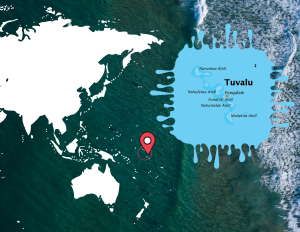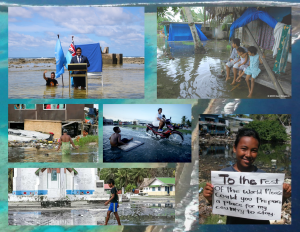Postcard 1: Map of Tuvalu

(blue map of Tuvalu from WorldAtlas.com) (other graphics from Canva.com)
This first postcard is meant to show Tuvalu’s location on the world map as well as an image showing the nation’s atolls (coral reefs enclosing a lagoon) and islands. As shown, Tuvalu is a small country located in the west-central Pacific Ocean about halfway between Australia and Hawai‘i. The physical land area is only 26 square kilometers and holds a population of about 11,000 people. Because of its location and physical nature, Tuvalu is very susceptible to the destructive effects of climate change and rising sea levels. As a result, its statehood is being contested. Because of climate change, the country may no longer meet the Montevideo Convention requirements of having a defined territory and permanent population, as citizens are fleeing from their sinking nation. The dripping graphics around the map of the country is intended to symbolize the effect of global warming- what Prime Minister Saufatu Sapo’aga referred to as a “slow and insidious form of terrorism against us” in 2003 before the United Nations (Allen 2004).
Postcard 2: Tuvalu Climate Change Collage
This second postcard is a collage of images depicting the present disastrous effects of climate change on Tuvalu. The background photo is an image of Funafuti Atoll, where the capital of Tuvalu is located.
The top left image is a photograph of Foreign Minister Simon Kofe giving his speech knee-deep in seawater during the 2021 United Nations Climate Change Conference in an effort to draw the attention of the international community to the very pressing issues of rising sea levels.
Below that image is a photograph of a woman wading through the water on the Funafuti atoll where the infrastructure has been impacted by the erosion and flooding of these low-lying areas (Ashley Cooper, Getty Images).
The image below of the young boy wallowing through water further shows the effects of erosion and destruction (UNDP Silke von Brockhausen). Similarly the photograph above shows a woman riding her scooter through a low lying area flooding at high tide near the country’s only airport in Funafuti (Mario Tama, Getty Images).
In the top right image, three Tuvaluan children are waiting out the highest annual tides called “King Tides” on their sleeping porch as the water infiltrates their roads and yards (Gary Braasch 2005).
The last image in the bottom right shows a Tuvaluan girl standing in front of flooding water and debris holding a sign which reads, “To the rest of the world please could you prepare a place for my country to stay” (Education for Sustainability Creative Commons). This plea for help is rooted in the climate migration of Tuvalu residents as they’ve been seeking refuge from climate change by moving to countries like Australia and New Zealand. As their islands and atolls are slowly sinking as a result of global warming caused primarily by these larger nations, Tuvalu is in need of international aid and support.
Postcard 3: Greetings from Tuvalu, Metaverse

(background image from Getty Images, postcard made with graphics from Canva.com)
This third postcard is an attempt to replicate the typical “Greetings from” postcards used to market a specific location to tourists. Rather than “San Francisco, California” this postcard shows “Tuvalu, Metaverse,” referring to the country’s Future Now Project. This project attempts to save Tuvalu’s national identity through the notion of climate mobility, where a country can still retain its statehood despite losing its physical territory. One of the initiatives under this proactive project is to build a digital nation so in the event that Tuvalu does need to mass migrate to another country, it could continue to function as a fully sovereign nation online. Foreign Minister Simon Kofe writes “Although Tuvalu stands against relocation as a solution to the climate crisis, in seeking to be proactive and practical, the project responds directly to the question ‘What will Tuvalu do if its land territory is lost to sea level rise?’” (Kofe 2022).
The first initiative of the project optimistically attempts to spread Tuvaluan values in order to promote diplomacy and motivate other nations to act on their shared responsibility in battling climate change. The second initiative, however, aims to politically and legally protect Tuvalu’s sovereignty by keeping the country’s maritime boundaries intact even after the land has disappeared. The third initiative is the last resort depicted by this futuristic postcard, where Tuvalu would shift its government operations to a different location and continue to function as a sovereign state by preserving its nation, history, and culture digitally.
Sources:
Allen, Leslie. “Will Tuvalu Disappear beneath the Sea?” Smithsonian.com. Smithsonian Institution, August 1, 2004. https://www.smithsonianmag.com/science-nature/will-tuvalu-disappear-beneath-the-sea-180940704/
Kofe, S. (2022, May 23). Tuvalu’s Future Now Project: Preparing for climate change in the worst-case scenario. Devpolicy Blog from the Development Policy Centre. Retrieved December 19, 2022, from https://devpolicy.org/tuvalu-preparing-for-climate-change-in-the-worst-case-scenario-20211110/

